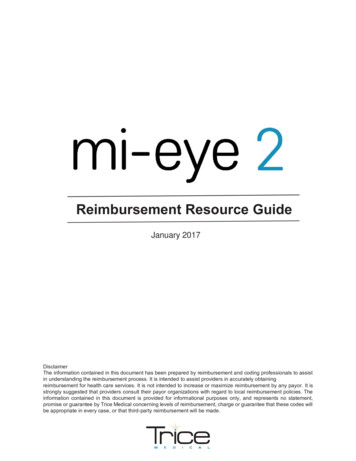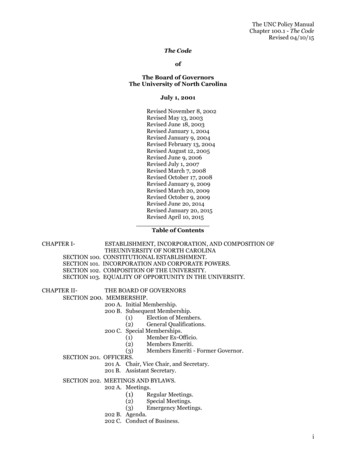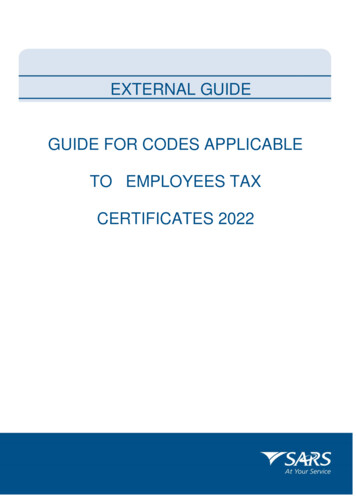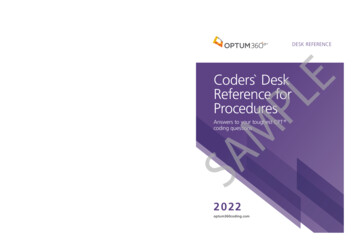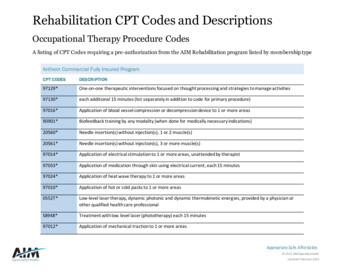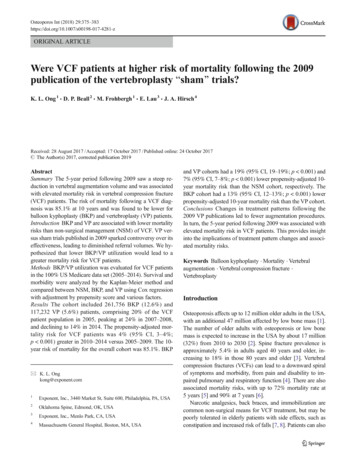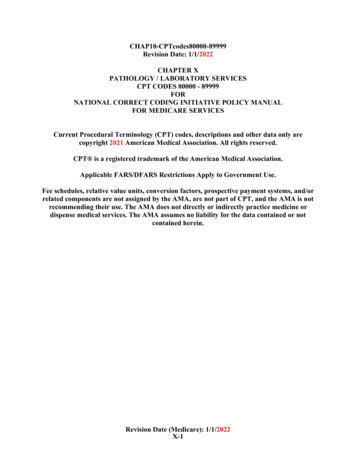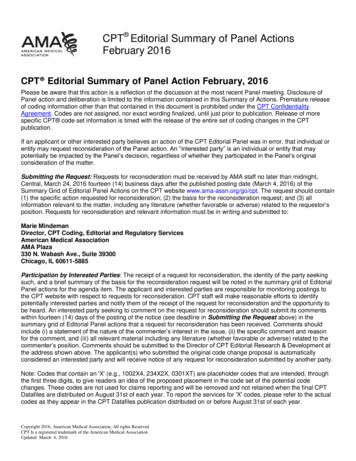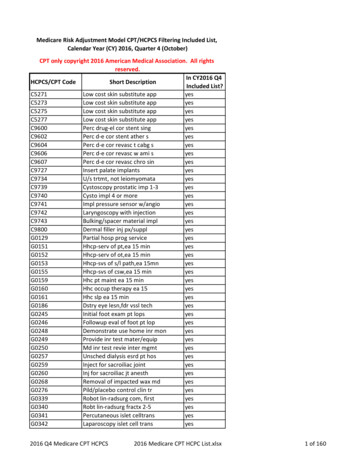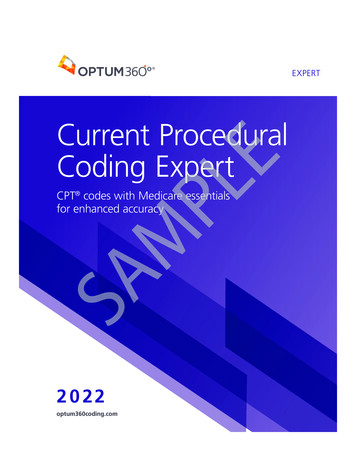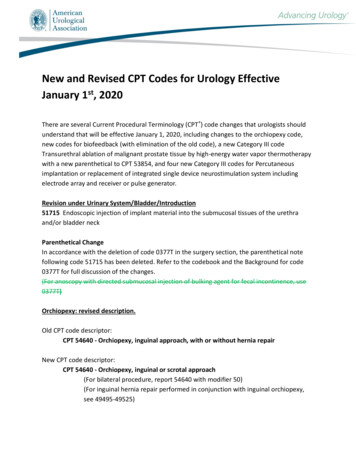
Transcription
New and Revised CPT Codes for Urology EffectiveJanuary 1st, 2020There are several Current Procedural Terminology (CPT ) code changes that urologists shouldunderstand that will be effective January 1, 2020, including changes to the orchiopexy code,new codes for biofeedback (with elimination of the old code), a new Category III codeTransurethral ablation of malignant prostate tissue by high-energy water vapor thermotherapywith a new parenthetical to CPT 53854, and four new Category III codes for Percutaneousimplantation or replacement of integrated single device neurostimulation system includingelectrode array and receiver or pulse generator.Revision under Urinary System/Bladder/Introduction51715 Endoscopic injection of implant material into the submucosal tissues of the urethraand/or bladder neckParenthetical ChangeIn accordance with the deletion of code 0377T in the surgery section, the parenthetical notefollowing code 51715 has been deleted. Refer to the codebook and the Background for code0377T for full discussion of the changes.(For anoscopy with directed submucosal injection of bulking agent for fecal incontinence, use0377T)Orchiopexy: revised description.Old CPT code descriptor:CPT 54640 - Orchiopexy, inguinal approach, with or without hernia repairNew CPT code descriptor:CPT 54640 - Orchiopexy, inguinal or scrotal approach(For bilateral procedure, report 54640 with modifier 50)(For inguinal hernia repair performed in conjunction with inguinal orchiopexy,see 49495-49525)
Background: CPT Code 54640 has been revised by deleting the words "with or without herniarepair“ and adding “or scrotal” to the descriptor language. This new description eliminates thepreviously confusing language to confirm the allowance of reporting the separate work ofhernia repair if significant and medically necessary if performed concomitantly with orchiopexy.In addition, the term “or scrotal” was added to the descriptor to better identify all approachesinherently included for the orchiopexy procedure. Code 54640 originally included language thatconflicted with instructions in a parenthetical note following the code listing which noted thatinguinal hernia repair performed in conjunction with inguinal orchiopexy may be reportedseparately. As a result, the term “with or without hernia repair” was removed to provide betterinstruction to users regarding report of 54640 in conjunction with hernia repair codes 4949549525. In addition, the term “or scrotal” was added to the descriptor for 54640 to ensure thatall approaches intended as part of the procedure are reflected within this code descriptor.Biofeedback: new and deleted codes.New CPT codes:90912 Biofeedback training, perineal muscles, anorectal or urethral sphincter,including EMG and/or manometry, when performed; initial 15 minutes of one-on-onephysician or other qualified health care professional contact with the patient.90913 . . . each additional 15 minutes of one-on-one physician or other qualified healthcare professional contact with the patient (List separately in addition to code forprimary procedure) (Use 90913 in conjunction with 90912) (For testing of rectal sensation, tone and compliance, use 91120)(For incontinence treatment by pulsed magnetic neuromodulation, use 53899)Deleted CPT code:90911 Biofeedback training, perineal muscles, anorectal or urethral sphincter,including EMG and/or manometry;Background: CPT Code 90911 was created in 1994. Since that time, biofeedback training forpelvic floor weakness has evolved and the amount of time spent with patients varied for eachsession. For this reason, code 90911 was deleted because the code did not truly represent the
amount of time for biofeedback training for pelvic floor weakness performed by the physicianor other qualified health care professional. It was determined that reporting biofeedbacktraining for pelvic floor weakness should be time-based. CPT Codes 90912 and 90913 describe15-minute increments of one-on-one physician or other qualified health care professionalcontact with the patient for biofeedback training of the perineal muscles, anorectal sphincter,or urethral sphincter. EMG and/or manometry is included, when performed. Relatedparenthetical notes were moved from deleted code 90911 and added following code 90913.New Category III Code for Transurethral ablation of malignant prostate tissue by high-energywater vapor thermotherapy, including intraoperative imaging and needle guidanceNew Category III CPT Code:0582T - Transurethral ablation of malignant prostate tissue by high-energy watervapor thermotherapy, including intraoperative imaging and needle guidance (Do not report 0582T in conjunction with 52000, 72195, 72196, 72197, 76376, 76377,76872, 76940, 76942, 77021, 77022) (For transurethral destruction of prostate tissue by radiofrequency-generated watervapor thermotherapy for benign prostatic hypertrophy [BPH] use 53854)Revised CPT code parenthetical:53854 Transurethral destruction of prostate tissue; by radiofrequency generatedwater vapor thermotherapy (For transurethral ablation of malignant prostate tissue by high-energy water vaporthermotherapy, including intraoperative imaging and needle guidance, use 0582T)Background: A new Category III code 0582T has been established for reporting transurethralablation of malignant prostate tissue by high-energy water vapor thermotherapy, includingintraoperative imaging and needle guidance. Parenthetical notes have been added to provideguidance on the appropriate reporting of code 0582T. Currently, code 53854 is used to reportthe indirect application of radiofrequency (RF) energy in the form of water vaporthermotherapy to ablate prostate tissue. New code 0582T is used to report transurethralablation of malignant prostate tissue by high-energy water vapor thermotherapy, includingintraoperative imaging and needle guidance. Exclusionary parenthetical notes were addedrestricting the use of code 0582T with other codes in the CPT code set.
New Category III code(s) for Percutaneous implantation or replacement of integrated singledevice neurostimulation system including electrode array and receiver or pulse generator,including analysis, programming, and imaging guidance when performed, posterior tibialnerveNew Category III CPT Codes:0587T Percutaneous implantation or replacement of integrated single deviceneurostimulation system including electrode array and receiver or pulse generator,including analysis, programming and imaging guidance when performed, posteriortibial nerve. (Do not report 0587T in conjunction with 64555, 64566, 64575, 64590, 95970, 95971,95972, 0588T, 0589T, 0590T)0588T Revision or removal of integrated single device neurostimulation systemincluding electrode array and receiver or pulse generator, including analysis,programming, and imaging guidance when performed, posterior tibial nerve (Do not report 0588T in conjunction with 64555, 64566, 64575, 64590, 95970, 95971,95972, 0587T, 0589T, 0590T)0589T Electronic analysis with simple programming of implanted integratedneurostimulation system (eg, electrode array and receiver), including contact group(s),amplitude, pulse width, frequency (Hz), on/off cycling, burst, dose lockout, patientselectable parameters, responsive neurostimulation, detection algorithms, closedloop parameters, and passive parameters, when performed by physician or otherqualified health care professional, posterior tibial nerve, 1-3 parameters (Do not report 0589T in conjunction with 64555, 64566, 64575, 64590, 95970, 95971,95972, 0587T, 0588T, 0590T)0590T Electronic analysis with complex programming of implanted integratedneurostimulation system (eg, electrode array and receiver), including contact group(s),amplitude, pulse width, frequency (Hz), on/off cycling, burst, dose lockout, patientselectable parameters, responsive neurostimulation, detection algorithms, closedloop parameters, and passive parameters, when performed by physician or otherqualified health care professional, posterior tibial nerve, 4 or more parameters
(Do not report 0590T in conjunction with 64555, 64566, 64575, 64590, 95970, 95971,95972, 0587T, 0588T, 0589T)Background: New Category III codes 0587T, 0588T, 0589T, and 0590T have been added toreport percutaneous implantation or replacement and revision or removal of integrated singledevice neurostimulators with analysis and programming and separate simple or complexelectronic analysis of implanted integrated neurostimulator system devices. In addition,parentheticals have been added within the Surgery/Neurostimulator andMedicine/Neurostimulators subsection and Category III code section to provide additionalinstruction regarding reporting of other neurostimulator electrode or generator implantation,removal, replacement, revision, imaging for placement and programming for these integrateddevices.Codes 0587T and 0588T have been established to report percutaneous implantation orreplacement and revision or removal of integrated single-device neurostimulators with analysisand programming. These codes have been added to identify the efforts of implanting orreplacing (0587T) or revising or removing (0588T) an integrated, single-device neurostimulator.These neurostimulation devices are comprised of an electrode array and integrated receiver ina single unit/device and are used at the posterior tibial nerve (lower leg) to treat overactivebladder and refractory urge incontinence. The implant is placed via a single percutaneousapproach, is permanent, and is powered by a generator (which is externally worn by thepatient). The difference in the make-up of the device (ie, use of a single device thatincorporates components that have typically been utilized and inserted as two devices – anelectrode array and a receiver or pulse generator) changes the work that is necessary for theplacement, removal, and revision procedures as no single code appropriately identifies theplacement of the electrode and the creation of the pocket for the receiver portion of thedevice.As a result, the new codes have been added to account for the differences necessary toperform these services. Imaging, programming, and analysis have been included as part of theplacement procedure (as noted in the code descriptor). Therefore, these services are inherentlyincluded as part of the procedures and not separately reported. Separate codes have beenestablished to identify electronic analysis with simple (0589T) and complex (0590T)programming. These codes are intended to be used when programming services are performedindependent of placement and revision/removal services. Guidance for this has been includedwithin the exclusionary parenthetical that follows each code. Other parentheticals within the
Category III section for these codes and in other section of the code set provide additionaldirection regarding the intended use for the new codes. These include exclusionaryparentheticals that restrict reporting of placement and programming services and crossreferences that direct users to the new codes for placement/replacement, revision/removaland programming services for percutaneous implantation or replacement of integratedneurostimulation system for the posterior tibial nerve.
New and Revised CPT Codes for Urology Effective January 1st, 2020 There are several Current Procedural Terminology (CPT ) code changes that urologists should understand that will be effective January 1, 2020, including changes to the orchiopexy code, new codes for biofeedback (with elimination of the old code), a new Category III code
